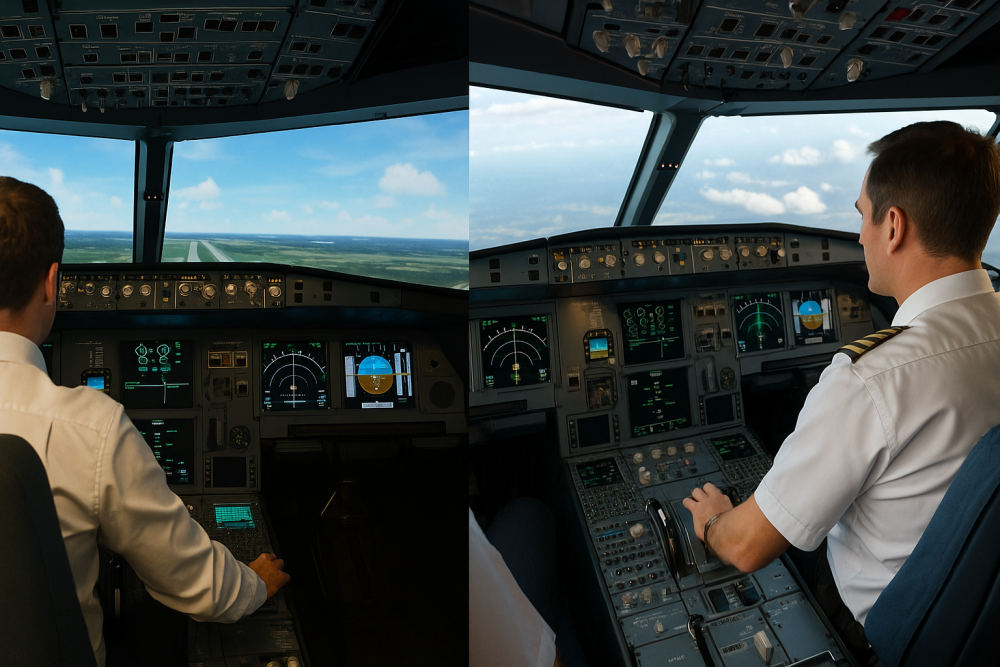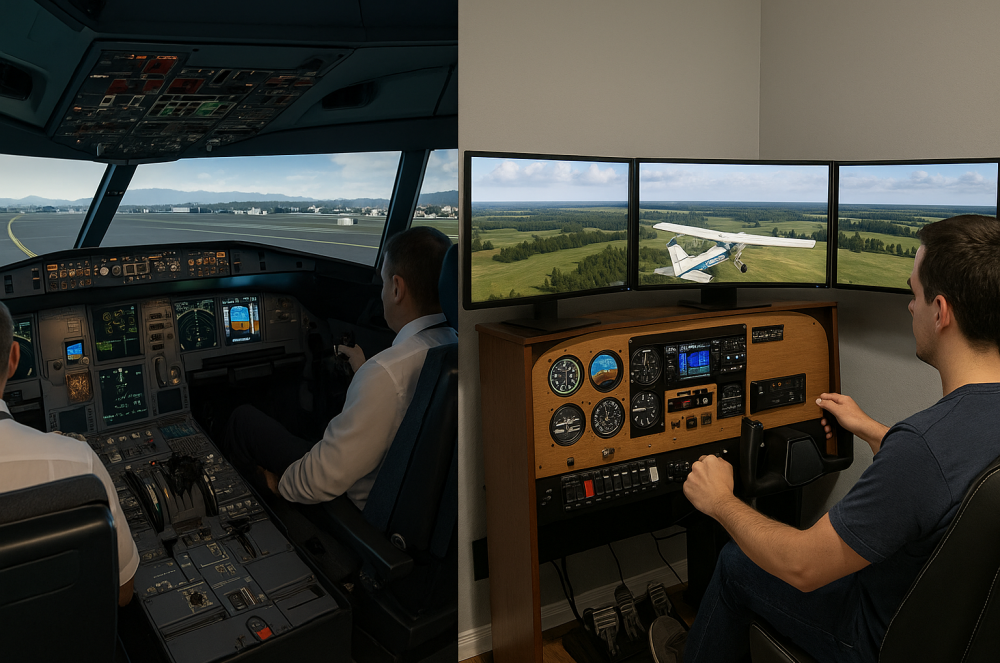Last updated on September 28th, 2025 at 09:26 am

I started using a flight sim a while back, and it still amazes me how much you can learn without ever leaving your desk. Flight simulators have come a long way — they’re no longer just a fun tool for aviation geeks or gamers. For many aspiring pilots, they’re becoming a serious part of the learning journey. From mastering cold-and-dark startups to practicing crosswind landings, today’s sims offer a safe, repeatable way to sharpen skills and build confidence before stepping into the real cockpit.
Let’s get real about the tech: there’s a world of difference between your home setup and what the pros use. The FAA and EASA have stamped approval on some heavy-duty, full-motion simulators. These beasts offer an almost uncanny replica of what it’s like to be up there in the real cockpit. Meanwhile, our home setups are pretty handy—even if they don’t come with motion platforms worth millions.
Whether you’re learning to navigate from A to B or digging deep into aircraft systems, simulators give you space to grow. For casual flyers, it’s part thrill, part hands-on learning. For future pros? It’s about building a foundation and gaining that extra edge before facing real-world flying challenges.
Realistic Elements in Flight Simulators That Enhance Pilot Skills

Alright, let’s get into what makes these simulators tick and why they’re worth every minute you spend in front of them. First thing first, procedural training is a big win. Whether you’re powering up a plane from a cold-and-dark state or programming complex routes into the Flight Management Computer (FMC), simulators offer a hands-on experience that textbooks just can’t match.
Got a knack for Instrument Flight Rules (IFR)? Simulators are golden for that. Navigating the virtual skies, setting up your Instrument Landing Systems (ILS), or following Standard Instrument Departures and Standard Terminal Arrival Routes (SID/STAR)? Yep, you can practice all of that. The experience builds confidence and precision, paving the way for smoother real-world flying.
And let’s talk cockpit layouts. It can feel like there’s a sea of buttons and switches in a real cockpit, right? Simulators let you get familiar with the avionics and instrument flow at your own pace. This way, your first live flight isn’t spent fumbling around.
Hardware is another plus. Got yokes, throttles, and pedals? Using them develops that muscle memory which is so vital — especially when paired with realistic hardware upgrades. Your brain and muscles get used to the movements, making it second nature when you’re up in the air.
Weather simulation takes things up a notch. Practice dealing with crosswinds, turbulence, and other tricky conditions you wouldn’t want to risk learning about for the first time when you’re actually flying.
And hey, don’t underestimate the power of good Air Traffic Control (ATC) simulation. Using networks like VATSIM and PilotEdge offers an immersive experience where you can hone your communication skills and stay sharp on procedures.
Recognizing the Limitations of Home Flight Simulators
Home flight simulators give us a chance to sharpen our skills, but let’s face it—they aren’t perfect replicas of real-world flying. The big gap? Motion feedback. You don’t get those G-forces pulling at your body or the vestibular cues telling you when you’re banking or climbing. In a real cockpit, you’d feel these sensations, helping your body sense the flight’s nuances.
Let’s talk tactile realism. Unless you’re shelling out big bucks for top-tier hardware, those plastic yokes and pedals just don’t quite feel like the real thing. They can help build familiarity but lack the tactile feedback of actual cockpit controls. So while your desk setup might look cool, it doesn’t quite capture the essence of gripping a real-world yoke or throttle. If you’re thinking about upgrading your control setup, check out our guide on yokes vs. joysticks to see what suits your flying style best. If you’re considering an upgrade, take a look at the best throttle quadrants for different aircraft types.
Another biggie is handling the chaos of real air traffic. Simulators can’t fully throw you into that high-pressure world where quick decisions are part of the gig. There’s something irreplaceable about the experience of real-world flying, where every sense is engaged, and stress levels are turned way up.
Now, about certification—most home simulators don’t meet the FAA/EASA standards that professional sims achieve. That means they’re fantastic for learning and practicing but remember, they can’t be used for official pilot certification or training progression. They’re a tool, not the total package.
Comparing Home Simulators with Certified Professional Simulators

When it comes to hardcore training, nothing really beats the full-motion certified simulators, especially those Level D beasts. They’re engineered to mimic everything, down to the slightest turbulence you’d feel at 30,000 feet. Airlines trust these machines for type-rating and serious emergency drills. It’s training that’s as real as it gets without leaving the ground.
But here’s the catch—they come with a price tag that’s sky-high. We’re talking millions, putting them out of reach for most enthusiast setups. These are usually reserved for big-time flight schools and airline training centers.
On the flip side, those of us running home simulators might not replicate every sensory detail, but we still pack a load of utility for pilots wanting to keep their knowledge sharp. Simulating routes, procedures, or just staying familiar with the avionics and cockpit layout—it’s all within reach when you’re focused on building confidence during your first takeoff and landing.
What’s great about home simulators is their flexibility — you can hop in anytime to sharpen procedures or experiment with new scenarios. They’re not a replacement for real-world flying, but they definitely keep your skills fresh and your reactions sharp, day after day. Optimal Scenarios for Utilizing Sim-Based Training
When it comes to flight sim training, you gotta know where they shine best. Planning to practice a specific route or approach? Simulators are your playground. They let you test out the journey without the pressures of being airborne, so when you’re actually up there, it’s like déjà vu but with more confidence.
Custom scenario training is another hot spot for sim training.. You can run through scenarios you hope you’ll never face in the real world. The pressure-free environment allows you to make mistakes, learn, and develop quick decision-making skills—something airline pilots value immensely.
Getting your cockpit flows down pat before the real deal can also be a game-changer. You’ll walk into your real-world flights with solid confidence, knowing where everything is and what needs to be done when chaos hits.
And don’t just take my word for it. Many real-world pilots are turning to sims like Microsoft Flight Simulator, X-Plane, or DCS to complement their training. These platforms bring a touch of realism and practice to your living room.
Even some pilot schools and instructors see the advantages, blending home simulations into their curricula. It’s a nifty way to extend learning outside the classroom and stay immersed in the aviation world.
✈️ Final Thoughts: From Desk to Cockpit
Flight simulators may not fully replace the real thing, but they’re an incredible tool for building muscle memory, refining cockpit flows, and sharpening your decision-making under pressure. Whether you’re prepping for a checkride, maintaining your skills, or just chasing realism from your home setup — every virtual flight gets you one step closer to thinking and reacting like a real pilot.
💬 Have you used a sim to prep for real-world flying or improve your technique? I’d love to hear your experience in the comments below.
👉 If you’re looking to upgrade your setup or deepen your skills, check out our Essential Flight Sim Hardware or explore realistic training scenarios to take your sim experience even further.
Fly smart, stay sharp — and keep pushing the boundaries of your virtual cockpit.
